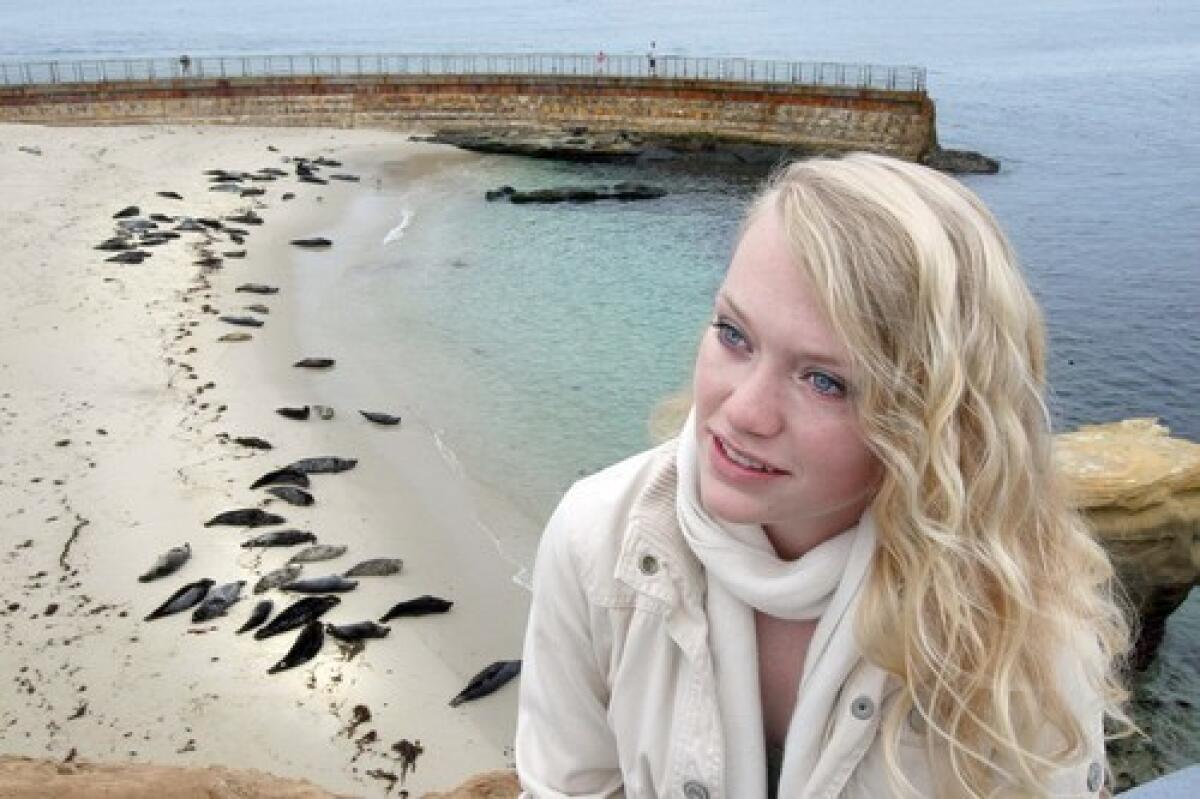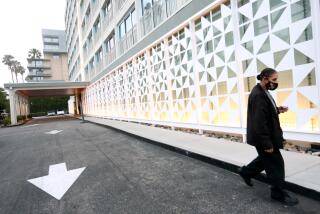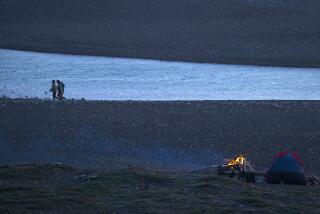Do La Jolla seals have squatters’ rights?

Summer Dunsmore, 19, glanced over her shoulder at the 50 or so harbor seals snoozing on a small horseshoe-shaped beach beside the Children’s Pool in La Jolla.
“Look at them,” said the La Jolla High graduate who is now a student at San Diego Mesa College. “They’re such peaceful creatures.”
Dunsmore has been organizing rallies this summer -- at the beach, at the downtown courthouse, even at the governor’s San Diego office -- in support of letting the seals remain on the beach, which was created when philanthropist Ellen Browning Scripps paid to build a breakwater in 1931.
The pinnipeds may be peaceful, but not the lawyers, politicians, city employees, federal officials and activists who are well into the second decade of controversy over whether the seals should be allowed to stay or should be scared away so the beach can be cleaned up for children.
Dunsmore is a second-generation activist. She remembers tagging along with her mother at an early protest rally when City Hall, under pressure from La Jolla residents, was considering evicting the seals.
At the moment, the seals appear to have the upper flipper. Gov. Arnold Schwarzenegger signed a bill last month changing the wording of the 1931 deed granted to the city for the beach.
The deed has long been interpreted as requiring the city to maintain the beach for children, as the newspaper heiress wanted. As amended by SB 428, however, the deed allows the city to declare it a marine sanctuary.
The passion in the dispute stems largely from its location. This is La Jolla, the most elite address inside city limits. A short walk from the beach is Prospect Street, San Diego’s equivalent to Rodeo Drive.
Plus, the Children’s Pool beach, although barely 100 yards long in a county with 70 miles of coastline, is special.
There are larger and, arguably, nicer beaches in La Jolla, but many residents have fond memories of swimming at the Children’s Pool or taking their children there.
Once the seals arrived in the early 1990s, the tourists were not far behind. With up to 200 seals lounging at the beach, swimmers and picnickers have since moved elsewhere. At one point, the beach was officially closed to people because the fecal count had reached extremely high levels.
No one knows why the seals abandoned an offshore sanctuary called Seal Rock just a mile away. But soon the Children’s Pool beach became possibly the most visible rookery -- where harbor seals give birth -- in Southern California.
The beach is just off Coast Boulevard. Visitors need walk only a few steps from the tour buses to get a good look.
With more tourists came more annoyance for La Jolla residents who want the seals gone. “I think for some people, it’s a matter that they like animals more than they like their neighbors,” said Mike Forbes, real estate agent and chairman of the La Jolla parks and beaches committee.
Among some La Jollans there is also a sentiment that letting the seals remain is disrespectful to the memory of “Miss Scripps,” who never married but devoted much of her fortune to the health and pleasure of children, including a public library, an aviary for the San Diego Zoo and Scripps Memorial Hospital. The site of her former home, a short walk from the Children’s Pool, is now the Museum of Contemporary Art.
A letter-writer to the La Jolla Light suggested that if the city does not disperse the seals, it should repay Scripps’ heirs for the cost of the breakwater.
Former Councilman Scott Peters said no other issue during his eight years representing La Jolla was so fraught with emotion. “It’s become two sides, and nobody is willing to compromise,” said Peters, who tilted pro-children but hoped, in vain, to find a way for both species to coexist.
The current City Council, which backed SB 428, would like to end the controversy by letting the seals remain. It isn’t that council members love seals more than children, but they are exhausted by the controversy and the legal bills.
The lawyer who has fought to enforce the original deed and oust the seals says the new law is illegal because the Legislature is trying to overturn a Superior Court decision that was in his favor.
“It’s unbelievable -- it’s just elementary civics,” said lawyer Paul Kennerson, who represents a client who would like the seals moved out. “If you can do that, you have no need for courts anymore. The Legislature can just set itself up as a super-court.”
If Kennerson succeeds at an Oct. 6 hearing in persuading Superior Court Judge Yuri Hofmann to reinstate his order that the city disperse the seals, Bryan Pease, an attorney for the Animal Protection and Rescue League, is ready to go to federal court.
The federal Marine Mammal Protection Act includes harbor seals among the animals to be protected.
The pingpong between the state court, bent on enforcing the 1931 deed, and the federal district court, backing the protection act, has prolonged the issue. The first order to clean the beach came in 2005 but was blocked by the federal court.
The city attorney’s office estimates that San Diego has spent $1 million in legal fees to private lawyers, much of it awarded by the courts to Kennerson for his various victories.
Kennerson makes no apologies. The city, he fumes, has been shameful in its treatment of the Children’s Pool by not removing the daily buildup of seal feces, allowing the lifeguard tower to rot and not repairing the rock breakwater or its rusting guardrails.
If ordered by the court, the city has a plan -- among other things -- to shoo away the seals by playing recordings of dogs barking, though even the mayor is skeptical. With the employees needed to run the public address system and police to protect against vandalism or worse by one side in the dispute or another, the city puts the total annual price tag at $700,000.
The pro-seal side stations watchers on the bluff 24 hours a day to ward off anyone who would harass the seals. Cameras are at the ready, and examples of anti-seal behavior are posted on YouTube.
An occasional drunk tries to “play” with the seals, said Marjane Aalam, co-founder of La Jolla Friends of the Seals. Aalam’s group has posted signs asking people to stay off the beach and, speaking on behalf of the seals, protesting, “We seals are citizens too! We have the right to rest and do our daily yoga undisturbed.”
There have been arrests of pro-seal and anti-seal activists. When it looked as though the city would have to begin moving the seals out, Mayor Jerry Sanders pleaded for both sides to remain civil.
Dunsmore, who hopes to attend UC Berkeley to study law and journalism, thinks the seal issue may come to a conclusion soon. “This is La Jolla, ‘the jewel,’ ” she said. “There are other beaches for people, but there’s only one for the seals.”
Forbes cautions that, if the council declares the beach a marine sanctuary, it could require hearings, a land-use permit and an environmental study.
“If it goes that way,” he said, “it’ll take another 20 years to settle.”
More to Read
Start your day right
Sign up for Essential California for news, features and recommendations from the L.A. Times and beyond in your inbox six days a week.
You may occasionally receive promotional content from the Los Angeles Times.






